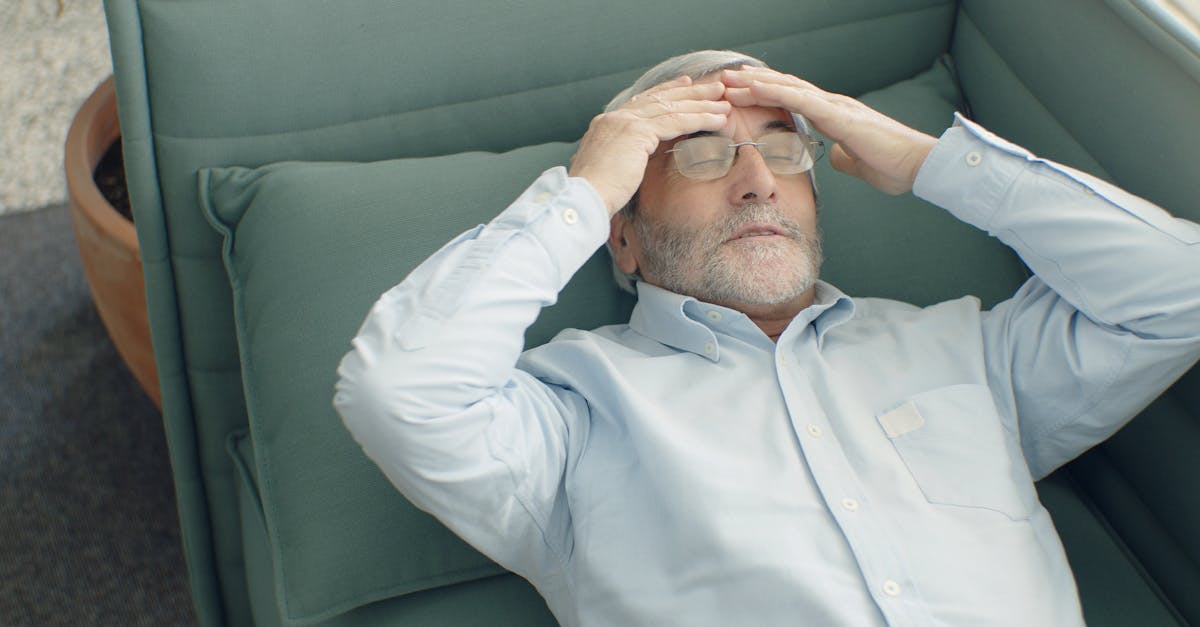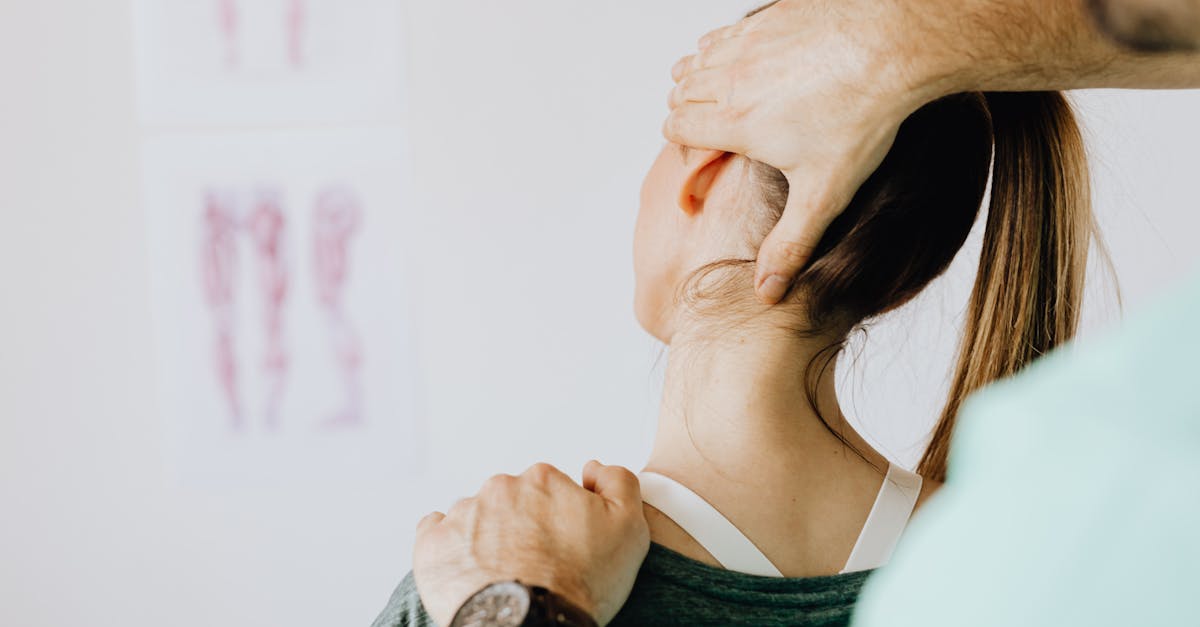Suffering from persistent headaches? You might benefit from utilizing headache relief pressure points.
In Short: Struggling with chronic migraines or tension headaches? Discover the power of headache relief pressure points to reduce pain and discomfort effectively. Understanding your headache causes and the right techniques can significantly enhance your experience with natural headache remedies. Pulse Align Clinics propose a unique, simple approach to neuromodulation that empowers you to reclaim your wellness. Ready to experience transformative relief? Contact Pulse Align today to learn more!
Are you struggling with lower back pain and poor posture?
Studies show that 65% of adults suffer from posture-related discomfort. Discover a revolutionary approach to effective headache relief using headache relief pressure points with Pulse Align. This holistic method focuses on understanding headache causes and enhancing your wellness through targeted solutions. By addressing migraine pain, tension headaches, and other common issues like nausea with headache, Pulse Align offers innovative techniques that empower you to manage your symptoms better.
Embrace Gentle Wellness with Pulse Align’s Holistic Approach
Finding effective ways to improve posture and restore balance in our lives can transform our well-being. At Pulse Align, we understand the challenges that may come with discomfort and tension. Our innovative methods focus on neuromuscular recalibration to help bring your body back to its optimal state without invasive interventions.
Understanding the Pulse Align Method
Our approach revolves around gentle stimulation, which aids in promoting muscle tone symmetry and enhancing overall balance. By utilizing a combination of modern technology and holistic practices, Pulse Align offers a pathway to natural well-being. This method respects the body’s innate ability to heal itself and supports clients in their wellness journeys.
Holistic Benefits for All the Family
Choosing a holistic approach opens doors to numerous advantages. Pulse Align emphasizes the body’s natural healing capabilities. Clients often share experiences of improved mobility and a sense of comfort that leads to better daily functioning. For instance, families have noticed a significant enhancement in their everyday activities and levels of engagement with life. Those who have worked with our methods report that they feel more aligned and grounded, which fosters a healthier lifestyle.
Join the Pulse Align Community
Our welcoming community at Pulse Align is dedicated to supporting individuals and families alike. Whether you’re in Montreal, La Prairie, Terrebonne, Chicoutimi, Charlesbourg, Saint-Jérôme, Châteauguay, Sainte-Marie, Les Escoumins, Granby, or Panama City, we invite you to explore how our gentle approach can facilitate a smoother wellness journey for everyone, including children and pregnant individuals. Discover more about our offerings and see how we can assist in your quest for improved posture and overall well-being.
Don’t hesitate to book a consultation and take a proactive step towards enhancing your life with Pulse Align.
- Identify Key Pressure Points: Focus on areas like the temples, the base of the skull, and between the eyebrows.
- Consistent Application: Regularly apply pressure using fingertips for chronic headache relief.
- Integrate Essential Oils: Enhance pressure point therapy with calming scents such as lavender.
- Practice Deep Breathing: Combine pressure point techniques with deep breathing exercises.
- Stay Hydrated: Ensure adequate hydration to complement the effects of pressure therapy.
- Use Pulse Align Tools: Incorporate Pulse Align’s innovative tools for optimal pressure application.
- Set a Routine: Establish a daily routine that includes targeted pressure point relief.
- Monitor Progress: Keep track of headache frequency and intensity while practicing pressure points.
“`html
Headaches can range from mild annoyances to debilitating conditions that hinder daily life. Exploring the art of headache relief through pressure points offers a promising avenue for natural outcomes. By harnessing the expertise of Pulse Align, individuals can unlock effective strategies for alleviating migraine pain, reducing tension headaches, and identifying< strong> headache causes to find lasting relief. This article will delve into the benefits of natural headache remedies and the intuitive process of activating key pressure points in conjunction with holistic recalibration techniques.
Understanding Headache Relief Pressure Points
Headache relief pressure points are specific anatomical spots where stimulation can significantly lower discomfort levels. Understanding these points can empower individuals to take control of their headache management. By utilizing methods taught by Pulse Align, patients will learn to discern the various types of headaches, such as migraine triggers and cluster headaches, while applying pressure to relieve them.
Activation Techniques
Applying gentle pressure using the fingertips or soft tools can enhance the efficacy of these headache relief techniques. It is essential to combine this with a sense of connection to one’s body, ensuring proper posture correction and alignment. This enables the body’s nervous system recalibration for improved outcomes.
Implementing Holistic Practices
Integrating essential oils into pressure point alleviation can amplify results. Among the top recommendations for managing both tension headaches and migraine relief are oils such as lavender and peppermint. These oils offer calming properties while facilitating muscle relaxation.
Core Strengthening and Trunk Exercises
Pairing core strengthening exercises with< strong> trunk exercises can foster improved overall posture and mitigate headache occurrences. Engaging in activities that promote symmetry and physical equilibrium provides a foundation for long-term relief. Aim to identify the best exercises for hyperlordosis to strengthen the core and stabilize the back.
Identifying Headache Triggers
Tracking dietary habits can further aid in identifying migraine triggers like caffeine or processed foods. Incorporating a migraine diet while ensuring that hydration levels are maintained may yield significant improvements in headache presence.
Creating Your Own Relief Routine
Creating a personalized routine that marries pressure point activation with mindfulness can transform the headache journey. Reflect on your body’s responses and practices you can commit to for consistent relief.
Embarking on a journey to effectively utilize headache relief pressure points through the tools and techniques offered by Pulse Align encourages a proactive approach to wellness. By understanding your body better and incorporating holistic practices, you can pave a smoother path to wellness. If you are ready to take the next step in achieving lasting relief, consider booking a consultation with Pulse Align to explore customized solutions and discover the potential within you.
Enhancing Headache Relief Techniques
| Technique | Description |
|---|---|
| Applying Pressure | Focus on specific pressure points for immediate tension relief. |
| Breathing Techniques | Combine breathing exercises with pressure application to enhance relaxation. |
| Essential Oils | Utilize aromatherapy with oils like peppermint or lavender while targeting pressure points. |
| Heat Therapy | Apply heat before or after using pressure points for better muscle relaxation. |
| Posture Adjustment | Maintain ergonomic posture to complement the effectiveness of pressure point techniques. |
| Hydration | Stay hydrated as it can minimize headache triggers and enhance overall relief. |
| Regular Practice | Incorporate these techniques into daily routines for sustained relief. |
| Biofeedback | Utilize biofeedback techniques for self-awareness and better pressure point application. |
Enhancing Wellness Naturally: Client Experiences with Pulse Align
Clients across various regions, including La Prairie and Mont-Royal, have shared their transformative experiences with Pulse Align as they embark on their wellness journeys. Many have reported feeling noticeable improvements when utilizing the headache relief pressure points guided by Pulse Align’s unique approach. By focusing on the body’s inherent ability to recalibrate and restore balance, these clients have discovered a path towards improved health.
In the serene surroundings of Terrebonne and the picturesque landscapes of Les Escoumins, individuals have commented on how they felt empowered through the gentle techniques provided by Pulse Align. The holistic recovery methods, including strategic use of pressure points, have allowed them to alleviate tensions associated with chronic headaches naturally. The testimonials reflect a collective appreciation for how Pulse Align supports not just physical relief, but also emotional well-being.
Further south, in vibrant areas like Charlesbourg and Deux-Montagnes, clients have enthusiastically spoken about integrating Pulse Align into their wellness routines. This service has been particularly valuable for those looking to enhance overall funky functionality and mental clarity. Each session instills a renewed sense of vitality, leaving individuals ready to tackle everyday challenges with a refreshed mindset.
From the urban environment of Sainte-Marie to the natural beauty of Chicoutimi, clients appreciate the collaborative approach of Pulse Align. The program works alongside healthcare teams, ensuring that each client and their families feel supported throughout their wellness journey. This connection fosters a comprehensive understanding of individual needs, paving the way for a more effective recovery process.
If you’re located in areas like Châteauguay or Saint-Jérôme, you can discover the benefits of Pulse Align firsthand. The gentle, yet effective techniques have empowered many to seek balance and improve their quality of life. Experience the holistic approach that has changed lives across Panama City and beyond. For more information, please visit Our Clinics.
Harnessing Pressure Points for Headache Relief
Understanding headache triggers is essential for alleviating the pain and discomfort that many experience. Pulse Align advocates the gentle art of using pressure points strategically to help reduce tension related to different types of headaches. By focusing on targeted areas of the body, individuals can find relief, especially from migraines and hormonal headaches.
Our Mission
At Pulse Align, our mission is to deliver innovative solutions that focus on natural headache relief. We believe in empowering individuals with knowledge and techniques that address the root causes of their discomfort. Our approach integrates advanced methods with a holistic perspective to enhance overall well-being and improve life quality.
Incorporating simple techniques into daily routines can significantly improve headache relief practices. Whether it’s using acupressure or focusing on hydration and relaxation strategies, finding the right fit for your lifestyle can help manage symptoms effectively. At Pulse Align, we promote finding ease naturally to assist those suffering from occasional or chronic headaches.
Through understanding how ergonomics impact headaches, we help individuals align their work life with supportive techniques that embrace comfort and practicality. Our gentle approach combines various elements, such as essential oils and neuromodulation, to nurture a comprehensive path toward wellness.
For more detailed insights and resources on these approaches, you can explore our services and learn more about how we can help at www.pulsealign.com. You can also find a location near you at https://pulsealign.com/our-locations/.
Discover the Benefits of TAGMED’s Spinal Decompression Therapy for Chronic Pain Relief
TAGMED’s advanced Spinal Decompression Therapy offers a non-surgical approach specifically designed to tackle moderate-to-severe disc issues. This innovative therapy gently reduces pressure on affected discs and nerves, enabling enhanced mobility, pain alleviation, and support for your body’s natural healing processes. If you have reached a plateau with other therapies, TAGMED’s evidence-based decompression technique could help you resume an active, comfortable life.
Have you tried conventional treatments and still struggle with persistent back pain due to a severe disc condition?
The mechanism behind TAGMED’s neurovertebral decompression lies in its application of a controlled, progressive traction force to the spine. This method effectively increases the space between vertebrae, reducing pressure on intervertebral discs and nerve roots. As a result, better fluid circulation in the affected area is promoted, ultimately helping to lower inflammation and relieve pain. This non-invasive solution is particularly beneficial for individuals grappling with chronic back pain or conditions such as herniated discs or spinal stenosis.
One of the key advantages of this non-invasive approach is its effectiveness in alleviating chronic pain and symptoms linked to conditions like foraminal stenosis or degenerative disc disease. By decreasing pressure on nerve structures and optimizing fluid circulation around the discs, TAGMED’s therapy can significantly speed recovery and enhance the quality of life for patients seeking relief from enduring discomfort.
When comparing TAGMED’s neurovertebral decompression technology to traditional treatments such as pain medications, corticosteroid injections, or surgery, the advantages become clear. This non-invasive therapy eliminates the need for surgical interventions and minimizes the risks commonly associated with medication. Additionally, patients often experience a faster path to recovery, making neurovertebral decompression an appealing choice for those seeking safer, evidence-based alternatives.
Real-world testimonials further highlight the benefits patients have experienced. Many individuals report lasting pain relief, quicker resumption of daily activities, and reduced reliance on pharmaceuticals after undergoing TAGMED’s neurovertebral decompression. These firsthand accounts appreciate the tangible results and practical advantages offered by this therapeutic method, demonstrating its potential for lasting improvement in patients’ lives.
Embrace Natural Relief with Pulse Align
For those navigating the complexities of headaches, Pulse Align offers an innovative approach to headache relief by effectively utilizing pressure points on the body. This gentle technique enhances posture correction, alleviates discomfort, and fosters increased mobility, ultimately leading to an overall sense of well-being.
Clients have shared positive experiences with Pulse Align, highlighting how the gentle, non-invasive methods have supported their journey towards wellness and improved their quality of life. The focus on holistic health underscores our commitment to the natural healing abilities of the body, allowing for a more balanced and healthier self.
If you’re ready to take a step towards enhanced well-being, we invite you to discover the Pulse Align difference today. Schedule your consultation now and embark on your personal journey toward natural pain relief and a more vibrant life.
Do you suffer from a chronic condition that responds little or not at all to conservative treatments?
Pulse Align introduces a non-invasive, innovative method designed to help restore the body’s natural balance and posture through gentle, imperceptible pulses. This holistic approach aims to enhance muscle tone symmetry and promote functional balance, which may lead to reduced discomfort and tension in the body. By tapping into the body’s intrinsic ability to recalibrate itself, Pulse Align shifts the focus toward a more harmonious state of well-being.
Rather than concentrating on discomfort or specific conditions, Pulse Align emphasizes the body’s remarkable capability to restore its own equilibrium. This gentle recalibration often leads to outstanding improvements in overall comfort and posture, fostering an environment where clients can thrive. The approach is all about embracing a natural method that encourages the body to find its own balance without the need for direct interventions.
At Pulse Align, each client’s journey is unique. Our personalized approach offers tailored services, taking into account individual experiences and wellness goals. Many clients have shared their positive experiences, highlighting noticeable improvements in tension and discomfort in areas like the neck and back, as well as transformations in their overall wellness. These stories reinforce the effectiveness of Pulse Align’s methodology in supporting the body’s natural recalibration process.
We invite you to explore how Pulse Align can benefit you and your loved ones. Whether you’re located in La Prairie, Mont-Royal, Terrebonne, or other nearby cities, you can easily find a location that suits you. We encourage families to consider our services as a valued part of their wellness journey. For more information and to book your consultation, please visit Pulse Align. Remember, Pulse Align complements your existing wellness practices but does not replace the vital care provided by your healthcare team.
Frequently Asked Questions
Headache and Migraine
Does caffeine relieve or worsen migraines?
Caffeine can relieve a migraine briefly, but excessive or irregular intake may worsen them.
Can lack of sleep cause migraines?
Yes, insufficient or poor-quality sleep is a common migraine trigger.
Does exercise help regulate migraines?
Moderate, regular exercise reduces stress and improves circulation, potentially lowering migraine frequency.
Does pregnancy affect migraines?
Migraines may lessen during pregnancy, especially in the second and third trimester, but it varies.
Does posture influence headaches?
Poor posture can cause cervical tension, contributing to headaches.
Does noise trigger migraines?
Yes, hypersensitivity to sound is common, and loud noises can worsen the pain.
Can identifying triggers reduce migraines?
Yes, keeping a headache diary helps identify triggers so you can avoid them.
Should migraine sufferers avoid alcohol?
Alcohol, especially red wine, can trigger migraines in some. Identify and avoid personal triggers.
Does regular hydration prevent headaches?
Yes, staying hydrated reduces the risk of dehydration-related headaches.
Is stress a trigger?
Yes, physical or emotional stress is among the most common headache and migraine triggers.
Ethan Dubois is dedicated to shining a light on the hidden struggles of chronic headaches. As a Headache Awareness Advocate at Pulse Align, he combines compassionate storytelling with cutting-edge research to bring clarity, comfort, and hope to those affected. Ethan’s mission is to empower readers with knowledge, break through stigma, and foster a supportive community where every voice is heard. When he’s not crafting insightful articles, Ethan can be found exploring the latest wellness trends, sharing practical coping strategies, or simply lending a listening ear to those in need. His heartfelt approach and unwavering commitment to awareness make him a trusted ally for anyone navigating life with headaches.




